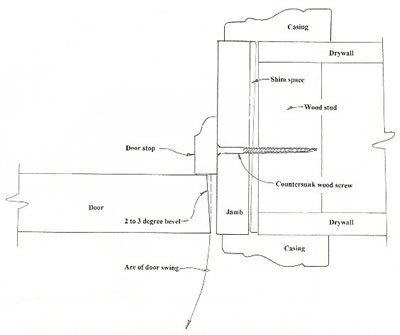
Buying the right interior doors.
Buying doors in the proper state of readiness is the most important step of interior door installation.
Step A
Determine what state of readiness you would like your doors to be in before ordering.
The first step in an interior wood door installation project is to determine what state of readiness you want your wood doors to be in. This important step will determine how difficult your door installation will be. Wood doors can be ordered a number of different ways. Wood doors are available as assembled prehung doors, partially assembled pre-hung doors, knocked down pre hung doors, un-machined slabs, fully machined slabs or partially machined slabs. They are also available as unfinished or pre-finished doors.
The vast majority of doors sold today are sold as assembled/pre-hung unfinished. This may not be your best choice however. You will have to determine what state of completion you should buy your doors in based on what phases of door hanging and finishing you would like to complete yourself, what tools you have available, how you would like to apply the finish and whether your doors are going into new construction or into existing jambs.
Assembled/ pre-hung doors come with the jambs fastened together, the door stop applied to the jambs, the hinges installed to the jambs, lock prep completed and the door beveled and hung on the hinges. Sometimes the door casing is also applied to one side of the jambs or both sides in the case of split jambs but we will not concern ourselves with split jambs or door casing at this time.
Partially assembled pre-hung doors are usually exactly like assembled/ pre-hung doors with one exception. The door stops are shipped loose instead of applied.
Knocked down pre- hung doors means all of the machining and prep work has been done on the doors and the jambs just as with assembled prehung doors but the jambs are not fastened together, the hinges are not installed to the jambs, the door stop is not applied to the jambs and the doors are not hung on the hinges. It usually takes about 5 to 10 minutes to put together a knocked down door unit into an assembled pre-hung door unit ready to install in the rough opening.
Un-machined slabs are doors that do not have hinge prep, lock prep, bevel, jambs, hinges or stop.
Partially-machined slabs are doors that do not have jambs, hinges or stop but may have hinge prep, lock prep or bevel completed.
Fully-machined slabs are doors that do not have jambs, hinges or stop but do have hinge prep, lock prep and bevel.
Unfinished doors are raw wood without primer, paint, stain, sealer or varnish applied to them.
Pre-finished doors have primer, paint, stain, sealer and/or varnish already applied to them.

Cross section of door and jamb components installed in wall
For unfinished doors in new construction I recommended that they are knocked down/ pre-hung. For pre-finished doors in new construction I recommended that they are either knocked down/ pre-hung or partially assembled/ pre-hung.
There are several advantages to purchasing your doors with knocked down jambs. One advantage is that you do not have to disassemble the door from the jambs and hinges for painting or varnishing. Most pre-finishers prefer to spray the finish on the doors while they are on a flat surface and not attached to the jambs. Another advantage is that you can apply the stain and finish behind where the door stop will be applied, something you can't do if the door stop is already fastened to the door jambs. If some adjustment needs to be made on the door stop you will not have a bare spot where there is no finish. Another advantage to having the door stop shipped loose is that you can drill and countersink holes behind the door stop to accept wood screws. Wood screws behind the door stop (see illustration above) is by far the superior method of installing the door jambs to the studs. Another advantage to knocked down jambs is that the doors are much easier to unload and carry into the house.
The 2 advantages to having your pre-hung doors assembled is that you can install them in the rough openings immediately upon arrival to the jobsite and you save about 5 to 10 minutes assembly time per door. One big disadvantage to buying your doors assembled is that the pre-hung door units can be very heavy and bulky and much harder to carry into the house without damaging something. The other big disadvantage is that if you hang your doors before finishing them you will either have to finish them in place, which is not recommended, or you will have to take them off the hinges to apply the finish then re-hang them. You will also have to finish the jambs in place.
If you really want your doors assembled/ pre-hung when they arrive on the jobsite I would recommend purchasing them pre-finished with loose stop.
Interior door installation and preparation |
If you have purchased your doors pre-hung but un-finished you need to decide if you want to apply the finish (paint or varnish) to your doors, jambs and stop before hanging them or hang them in the openings and apply the finish at a later date. Pre-finishing is usually the best unless you are hiring a professional painter to come in and do them on the jobsite in which case you should take their recommendation.
|
|
If you have purchased your doors knocked down/ pre-hung the next step after pre-finishing would be to drill and countersink the holes in the jambs for the wood or drywall screws. These holes should be directly behind where the center of the door stop will be. Spacing for these holes is optional. I usually put a screw 4" down from the top of the jamb and 4" up from the bottom and about 12" apart. One screw is usually enough for the head jamb up to 36" wide.
|
Step B
Floor clearance
Determine if you need to shorten the bottom of your side jambs. Usually the jambs extend 1" past the bottom of the door. This gives you approximately 1" of floor clearance. If you do not want this much floor clearance you will have to shorten your side jambs accordingly. If carpet is being installed on both sides of the door and you need more than 1" clearance under your door you can raise the jambs off the floor as long as you have enough height in your rough opening. If you do not have enough rough opening height to do this you will probably have to trim the bottom of the door off after it is hung.
If a vinyl, tile or hardwood floor is on either side of the door you will need to make sure your jambs extend all the way down to the finished floor. If the finished flooring is already installed you will just set the jamb directly on the finished floor. If you are hanging the door before the finished floor is installed you can either block up the jambs the same thickness as the finished floor or set the jambs directly on the sub-floor and let the flooring installers trim the bottom of the side jambs in place. Once again make adjustments to the jamb length based on what you want your bottom door clearance to be. Don't forget to allow for throw rugs. |
|
After trimming the bottom of the jambs (if needed) it is now time to assemble the jambs. Make sure you put the proper door with the proper jambs. Check the swing of the door either right hand or left hand. Also
make sure the jambs are the proper handing and the proper width for the opening. Check the length of the head jamb to make sure it is exactly the right length before assembling the jambs. If you have an air gun you can staple the side jambs to the head jamb using 1-1/2" or longer staples. If you do not have an air gun you can hand nail or screw the side jambs to the head jamb using 8d nails, drywall screws or wood screws.
|
|
Once the jambs are fastened together it is now time to install the hinges. Take the hinge pins out of the hinges so that the 2 halves of each hinge are separated. Install the corresponding hinge halves one to the door and one to the mating jamb. After all hinges are installed you are now ready to put the jamb unit in the rough opening. Make sure you have the jamb in the opening the proper direction. Before actually hanging the door to the jamb I usually like to secure the hinge side jamb to the stud. Using wood shims and a level make sure it is plumb and straight. Now you can hang the door to the jamb. Close the door as far as you can and hold the level vertically on the leading edge of the door to check it for plumb. If your jamb is perfectly plumb your door should also be perfectly plumb. If you need to make some adjustments simply back off the screws to adjust your shims. Don't cut your shims off until both jambs are secured and fitted exactly the way you want them.
After your door is lined up with the jamb exactly the way you want it and all of the jamb screws are installed to hold the jamb in place you can now cut off your shims flush with the wall using a utility knife. The door stop can now be installed. |
Step E
Installing the door stop
To install the door stop accurately the locksets should be installed first. After the locksets are installed you are now ready to install the door stop. Measure the distance from the floor to the head jamb on both the hinge side and the lock side of the jamb. These measurements should be the same but they could vary slightly. Cut a 45 degree miter on one end of each piece of the door stop legs to the proper length. Install the lock side door stop first. With the door latched in the closed position hold the corresponding door stop against the door on the lock side making sure the door is positioned so the latch is tight to the door stop and the stop is pushed up tight to the head jamb. Using an air finish nailer, nail the stop to the jamb. Or nail it by hand using 4 penny finish nails. Repeat the process to install the hinge side door stop but make sure you leave about a credit card clearance between the stop and the door. If the hinge side stop is nailed up tight against the door it could interfere with the door closing. After both side stops are nailed in place measure the head stop and cut a 45 degree miter on both ends. The head stop should be cut tight enough so that you have to bow it down slightly to snap it into place. This will ensure a tight fit. Nail in the head stop and your door jambs are now ready for door casing. |
Prepping your own door slabs for existing jambs
Occasionally some home owners want to replace their doors but don't want to replace their jambs or door casing. This means you will have to have the company you purchase your doors from do all or part of the prep work or you will need some degree of skill and equipment to do the prep work yourself. There are basically 3 operations that need to be completed to a door slab to prepare it for hanging in an existing jamb. The door slab needs to be beveled, mortised for hinges and prepped for the lockset.
|
|
|















